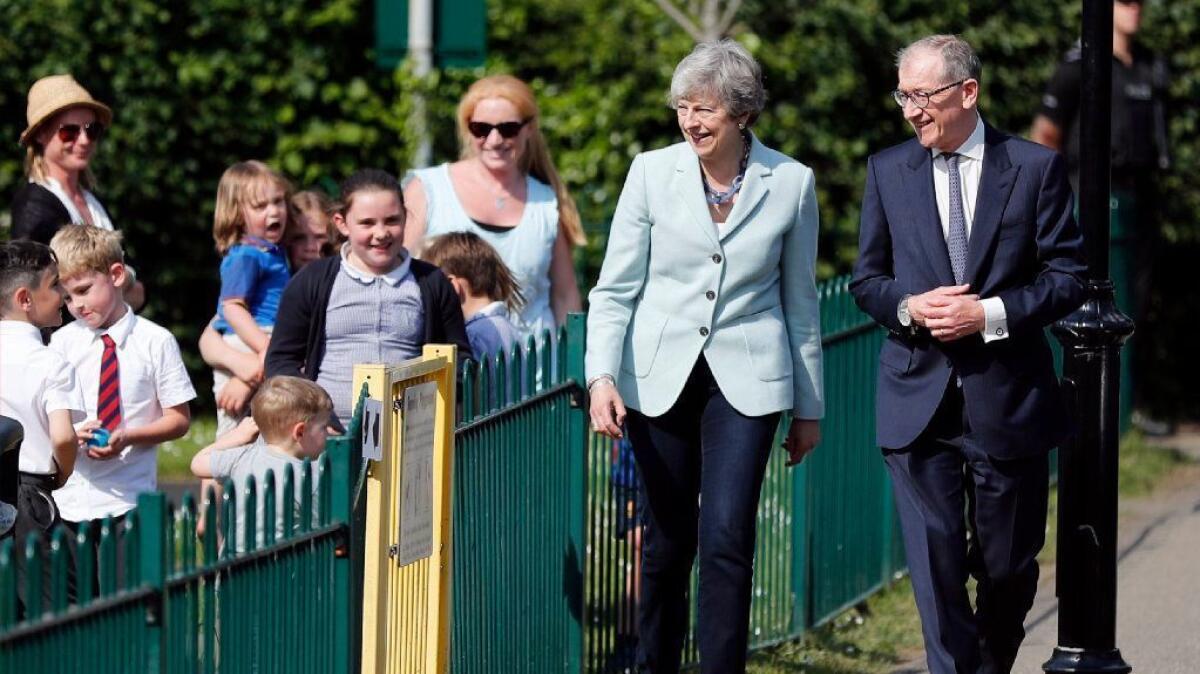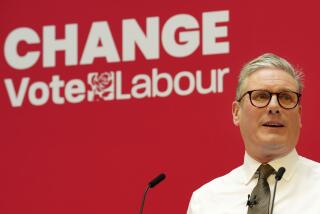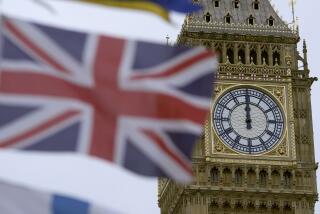Britain’s Theresa May: A political deathwatch for a prime minister done in by Brexit

Reporting from London — British politicians agree on precious little these days. But on one matter, there’s near-unanimity across the spectrum: Theresa May’s days as prime minister are numbered.
The political deathwatch comes against the backdrop of Britons’ vote Thursday for the European Parliament — balloting that would not have taken place if the country had left the European Union as scheduled nearly two months ago.
The newly constituted Brexit party — which, as its name suggests, is devoted to getting Britain out of the EU as soon as possible — was expected to triumph, although results will not be announced until Sunday, when all 28 nations in the bloc have finished voting.
In the meantime, May was being treated, even by senior members of her own party, as a pariah. Speculation about the prime minister’s likely ouster reached fever pitch as fellow Conservatives publicly excoriated her fourth and latest proposal setting terms for Britain’s departure from the EU, as approved by voters in the Brexit referendum in June 2016.
An important Cabinet member, Andrea Leadsom, quit late Wednesday — the 36th such ministerial departure since May took office nearly three years ago — expressing a lack of confidence in the government’s approach.
When the prime minister made a visit to Buckingham Palace on Wednesday, news reports portrayed her regularly scheduled audience with the queen as a grim milestone. A BBC report — in funereal tones suggesting that May, like some luckless historical figure, was about to be whisked away to the Tower of London for the coup de grâce — declared it would probably be one of her last trips through the palace gates.
In another ominous portent, a key party committee on Wednesday held a secret ballot — without publicly disclosing the results — over whether to change party rules to allow an early vote of confidence in the prime minister. May won the last one, in December, and under party rules, another was not supposed to occur for 12 months.
Thursday’s headlines were predictably savage.
“May set to go after Brexit fiasco,” said the Sun tabloid. “May hides away as Cabinet bangs on No. 10 door,” the Evening Standard declared on its front page, referring to reports that the prime minister had ducked meetings with alarmed senior aides.
May’s foreign secretary, Jeremy Hunt, said Thursday that the prime minister would still be in office June 3, when President Trump pays a visit. That could be a mixed blessing, as the U.S. president’s visits are traditionally bruising affairs for the prime minister.
On past trips, Trump has enthusiastically praised May’s political opponents and suggested that Brexit would have gone off smoothly if May had taken his negotiating advice.
It’s been clear for many months, as May’s proposed Brexit deals were serially rejected by Parliament, that her grip on power has waned.
In April 2017, she called early elections meant to bolster her strength but instead lost badly and maintained her parliamentary majority only by teaming up with a Northern Irish party whose complicated Brexit aims diminished her ability to strike a compromise.
When she fought off a party leadership challenge in December, May had to promise that she would not be leading the Conservative Party in elections set for 2022.
Only a month after that, May suffered one of the worst parliamentary defeats of modern times when lawmakers overwhelmingly rejected the Brexit withdrawal agreement she had struck with European Union leaders, throwing the whole process into disarray.
In a bid to stave off ouster, May has moved up her own projected departure date. In March, she promised to quit before the next phase of Brexit negotiations begin. It’s unclear when that will be, but the current target date for splitting with the EU is the end of October.
Last week, May dangled the promise of departing within weeks, after her current withdrawal plan gets a second parliamentary reading. But the government on Thursday put off planned publication of the legislation until June 3 — yet another sign that there was no support for it.
On Thursday, May met with Hunt and her home secretary, Sajid Javid, seemingly trying to project willingness to address her Cabinet colleagues’ concerns about her political future and the viability of her Brexit plan. Then she went to her home constituency to cast a ballot in the EU vote, but she said nothing publicly.
The next inflection point could be Friday, when May is to meet with Sir Graham Brady, the head of the 1922 Committee, a powerful Conservative political body that in the past has let prime ministers know that the time has come to go.
A rare show of support came from a fellow Conservative politician, Margot James, who suggested May was being “hounded out of office” because of Parliament’s failure to find common ground on how and when to carry out Brexit. But even she seemed to bow to the inevitable.
“In the end,” she said, “there’s got to be a compromise.”
Special correspondent Boyle reported from London and staff writer King from Washington.
More to Read
Sign up for Essential California
The most important California stories and recommendations in your inbox every morning.
You may occasionally receive promotional content from the Los Angeles Times.










